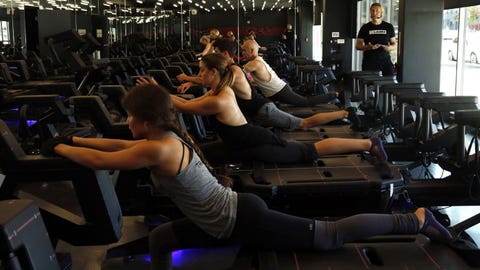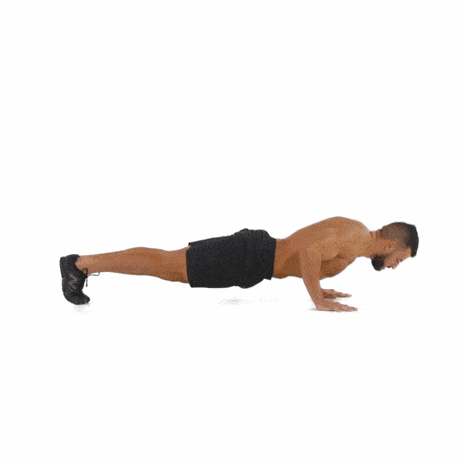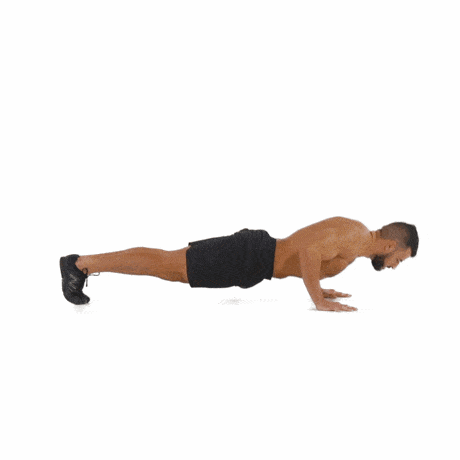
Looking for a way to vary your workout and challenge yourself at the same time? Just slow down.
Sebastien Lagree recommends giving your workout regimen the slow motion treatment that focus on time under tension (TUT) — regardless of how much the impatient guy at the gym stews waiting on you to get off the bench.
The former bodybuilder turned fitness engineer believes it’s better to lift slower for more intensity than lifting heavier weights. And his clientele, which has included Kim Kardashian, Meghan Markle, Sofia Vergara, former MLB star Johnny Damon, and NBA guard Courtney Lee, have bought into Lagree’s philosophies. His Lagree Fitness Method is now taught in over 300 locations worldwide, where his Megaformer and Supra machines are used to sculpt bodies through slow, controlled movements against resistance.
See what NBA star @courtneylee thinks about his workout at @lagreefitwindermere ! known as home of the first round picks when it comes to athletes , from our MLB family to the NBA … Today we are proud to join @courtneylee shooting guard for the @nyknicks to our family !! He had a blast with us today and here is a sneak peak of how this NBA star stays in Shape! #nba #proathlete #lagreefitness #lagreemethod
A post shared by Lagree Fit (@lagreefitwindermere) on
Lagree is an advocate of a radical TUT practice during weight training exercises, with even longer periods than other trainers who use similar methods or the established science typically calls for. He teaches clients to move slowly, and works them up to holding at least one minute on each the positive and negative side of a lift or exercise to put their muscles in a state of stress.
While Lagree readily admits that TUT exercises can’t measure up to routines emphasizing explosive movements with heavy weights for people who train to gain muscle mass, he believes incorporating TUT is imperative for everyone else who works out with the goal of looking good.
“Time under tension might not be as effective as explosive movements at getting muscles to respond, making them bigger,” Lagree told MensHealth.com. “But I think for the people who really want to basically tone and get sculpted, I think that doing a longer duration and a slower time is going to be more effective [than lifting heavy].”

Rick Howard, M.Ed, C.S.C.S., and NSCA Mid-Atlantic Regional Coordinator, isn’t exactly sold on that claim for TUT exercises.
“I think that for most people who are lifelong devotees of exercise training, being able to vary your workout to include more time under tension, that makes a lot of sense,” he told MensHealth.com. “But to think that one type of training will give you this effect better than another one, that’s a tough one. It depends on your goals. If your goal is to be bigger, stronger, faster… probably not. If your goal is just to vary your workout and have something different to do to get your body to respond, [TUT is] OK.”
Howard also flat out said “no,” when asked if TUT exercises are safer and better preventing injury than regular or explosive movements. He pointed us in the direction of this recent infographic research, which takes a deeper dive into understanding time under tension, muscle fibers and stimulating muscle growth:
If muscle fibers are stimulated to increase in size after they detect the presence of mechanical tension, then the force-velocity relationship must be the starting point for understanding hypertrophy. pic.twitter.com/QvBmHhDStw
Even with detractors, Lagree stands by his claim that TUT techniques trigger your muscle fibers in different ways and are safer.
“It really forces your body to stimulate more muscle fibers,” he insisted. “I think that going slower without momentum is safer way to stimulate the muscles than way you do with faster momentum. Moving slower helps to stay in the proper alignment and to eliminate or reduce the risk of injuries. It’s a great way to re-strengthen and tighten and tone the muscles over the years.”
Lagree recommends starting with 50 percent of your one-rep max weight across a variety of exercises and making that number your new TUT one-rep max. So, if you bench 200 lbs., aim for 100, while shooting for eight to 10 seconds down to your chest and another eight to 10 seconds while lifting the bar back up. Lagree says as you get comfortable with lifting slower, add 10 seconds to each the positive and negative rep per exercise until you reach one minute for each and really feel the burn.
If you’re interested in giving time under tension a shot, Lagree gave us these exercises as basic starters to begin with. He advised that you use his aforementioned 50-percent weight formula, to start, and concentrate on only one rep. Do these TUT moves with free weights or on a machine.
Just don’t worry about comparing this workout to your other training. When asked what the rep equivalent of one TUT exercise would be for regular reps of the same movement, Lagree said: “I don’t know if you can say it’s equivalent to a number of repetitions. It works differently. I think the muscle and the body have to think differently [with TUT] because it’s a much deeper stimulation.”
Instead, we suggest that if you want to give TUT a shot, use the training to try something new, as Howard suggested. Just be careful to work with weight you can control safely — you can always increase the weight and time spent under tension if it feels too easy.
The Exercises
*All exercises should be performed for 8 to 10 seconds on each the positive and negative portion of the lift, for 1 rep to start.
Bench Press


Men's Health
Lagree didn’t hesitate to call the bench press the ideal exercise to start experimenting with time under tension.
“Lower the weight fully down to your chest. When you bring it back up to full extension, you should not be able to do one more rep after that,” he said of the 16- to 20-second move. “It’s kind of reaching muscle failure in one rep. If you feel like you could do a second repetition, you probably don’t have enough weight or you could go longer.”
Hamstring Leg Curl
Whether lying face-down or seated, you already feel all the isolated tension when doing a hamstring leg curl. Now, aim to control it slowly to feel every fiber in the back of your legs.
Lat Pulldown
Lat pulldowns are sort of perfect for TUT. Think about it. You’re seated comfortably and stable. Now, it’s about mastering the control of the movement. “Try to bring the bar all the way down to the chest and then slowly release it up,” Lagree said. “When you go into the opposite phase, you’ll find you’re going so slow that your body doesn’t know if you’re pulling or pushing. Right after the rep, you’ll feel a throbbing in the entire area you worked on.”
Tricep Extension or Pushdown


Men's Health
Slow and steady, try a tricep extension or pushdown without your arms shaking. Feel comfortable with that full control? Add 10 seconds at a time. It’s going to get harder, promises Lagree.
Pushups


Men's Health
Pushups are a great place to start experimenting with TUT without adding a load . Use the same principles as the other exercises to work your pushup form, focusing on maintaining a solid core while engaging your glutes throughout the rep.
Source: Read Full Article
